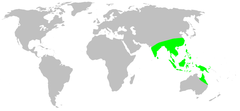Psechridae
| Psechridae Temporal range:
| |
|---|---|

| |
| Fecenia cylindrata | |
| Scientific classification | |
| Domain: | Eukaryota |
| Kingdom: | Animalia |
| Phylum: | Arthropoda |
| Subphylum: | Chelicerata |
| Class: | Arachnida |
| Order: | Araneae |
| Infraorder: | Araneomorphae |
| Family: | Psechridae Simon, 1890 |
| Genera | |
| |
| Diversity | |
| 2 genera, 77 species | |

| |
Psechridae is a family of araneomorph spiders with about 70 species in two genera.[1][2] These are among the biggest cribellate spiders with body lengths up to 2 centimetres (0.79 in) and funnel webs more than 1 metre (3 ft 3 in) in diameter.[3]
The family belongs to the RTA clade of spiders because they all have a Retrolateral Tibial Apophysis on the male pedipalp. A recent phylogenetic analysis places Psechridae as close relatives of the lynx spiders, wolf spiders, and nursery web spiders.[4]
They feature several characteristics normally found in ecribellate spiders, for example brood care behavior, and a colulus with no apparent function.[5] They have greatly elongated legs, with the last element being very flexible. Female Psechrus carry their egg-sac in the chelicerae, similar to their relatives, the ecribellate Pisauridae. Members of Psechrus construct horizontal webs lace webs, while Fecenia construct pseudo-orbs, similar to orb webs of Orbiculariae spiders in an example of evolutionary convergence.[4][6]
Distribution
[edit]They occur in southeastern Asia, ranging from India in the west, to Solomon Islands in the east, reaching as far south as northern Australia, and north to central China.[7] They are found in forest, rocky areas, and caves from lowlands to altitudes exceeding 2,000 metres (1.2 mi).
Genera
[edit]As of April 2019[update], the World Spider Catalog accepts the following genera:[7]
- Fecenia Simon, 1887 — Asia, Australia
- Psechrus Thorell, 1878 — Asia, Australia
- †Eomatachia Petrunkevitch, 1942 (fossil, oligocene)
See also
[edit]References
[edit]- ^ Bayer, S. (2011). "Revision of the pseudo-orbweavers of the genus Fecenia Simon, 1887 (Araneae, Psechridae), with emphasis on their preepigyne". ZooKeys (153): 1–56. doi:10.3897/zookeys.153.2110. PMC 3238043. PMID 22287909.
- ^ Bayer, S. (2012). "The lace-sheet-weavers—a long story (Araneae: Psechridae: Psechrus)". Zootaxa. 3379: 1. doi:10.11646/zootaxa.3379.1.1. S2CID 86223774.
- ^ Gertsch, Willis J. (1979). American Spiders (2 ed.). Van Nostrand Reinhold, New York. ISBN 0-442-22649-7.
- ^ a b Agnarsson, I.; Gregorič, M.; Blackledge, T.A.; Kuntner, M.; et al. (2013). "Phylogenetic placement of Psechridae and the convergent origin of orb-like spider webs". Journal of Zoological Systematics and Evolutionary Research. 51. doi:10.1111/jzs.12007.
- ^ Fang, K.; Yang, C.-C.; Lue, B.-W.; Chen, S.H.; Lue, K.-Y.; et al. (2000). "Phylogenetic Corroboration of Superfamily Lycosoidae Spiders (Araneae) as Inferred from Partial Mitochondrial 12S and 16S Ribosomal DNA Sequences" (PDF). Zoological Studies. 39 (2): 107–113. Archived from the original (PDF) on 2006-09-08. Retrieved 2007-05-29.
- ^ Blackledge, T.A.; Kuntner, M.; Agnarsson, I. (2012). "Biomaterial evolution parallels behavioral innovation in the origin of orb-like spider webs". Scientific Reports. 2: 833. Bibcode:2012NatSR...2E.833B. doi:10.1038/srep00833. PMC 3495280. PMID 23150784.
- ^ a b "Family: Psechridae Simon, 1890". World Spider Catalog. Natural History Museum Bern. Retrieved 2019-04-23.
Further reading
[edit]- Levi, H.W. (1982). The spider genera Psechrus and Fecenia (Araneae, Psechridae). Pacific Insects 24: 114-138. - revision of the family
- Wang, X.P. & Yin, C.M. (2001). A review of the Chinese Psechridae (Araneae). J. Arachnol. 29: 330-344. PDF Archived 2007-09-30 at the Wayback Machine
